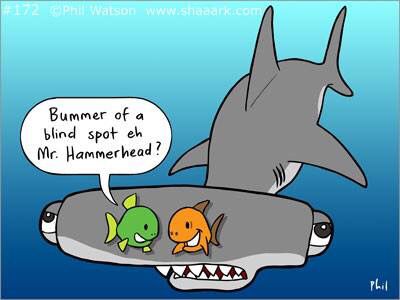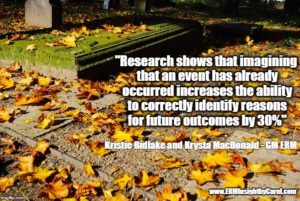We all wish we could have a crystal ball to gaze into and learn what the future holds for our business…
Being able to proactively identify what might be coming down the road in the next month, next year, or next couple of decades is invaluable in helping companies chart their future course.
Methods for identifying future risks was the subject of a presentation I had the pleasure of attending at RIMS’s ERM conference in Atlanta last October and again on a recent webinar. The presenters, Kristie Bidlake and Krysta MacDonald of General Motors, explained how they facilitate this process at one of the world’s largest automakers.
Risk sensing – 7 techniques used by GM for identifying future risks
While a crystal ball would be ideal, the following 7 methods are the best alternatives at GM’s disposable for identifying future risks. These techniques allow the enterprise risk management (ERM) team and senior management to get fresh perspectives on what may be awaiting the company either later in the year, in the next 5 years, or even a generation into the future.
The ultimate goal of these methods, besides identifying future risks, is to increase risk awareness and conversation within the various business units within the company.
- Sensing Network – GM uses two groups of people from within the company: 1) a network of 100+ risk officers across the company, and 2) a “sensing committee,” which is a large group of directors and managers from throughout the company who meet quarterly to discuss risks and share data that can help the company better manage operations. Members of the sensing committee are experts in their respective fields, and taken as a whole, represents a broad range of knowledge.
- Examining global megatrends – This method involves looking at large areas that can impact not just GM, but a broad range of organizations. For example, digitalization will have a profound impact on the entire world for a long time to come. Not only does GM have to understand how these megatrends will affect their operations, they have to consider how they will impact their customers so they can adapt their products to meet these needs.
- Blindspot workshops – As the name implies, these workshops try to find the risks that no one is considering or even knows about – the “unknown unknowns” as Kristie and Krysta explain. Blindspots arise due to complexities within the organization, submissive subordinates, or a business unit’s over-confidence. A blindspot workshop at GM involves around 20-30 people from different business units and varying age groups using a “rapid fire” approach. There are just two rules: 1) everything is written down, and 2) there are no “no’s” or “but’s” heard in these sessions. To get the brain juices flowing, the group is presented with megatrends and other data. Also, participants in the workshop are separated from their direct supervisors so they can feel comfortable offering their candid assessments.

- Professional publications and networks – Reviewing industry journals, business publications and engaging in professional networks is another way for identifying future risks. What are other automakers talking about? What are other professions like accounting or legal talking about that may be applicable to GM? Reaching out into the broader world provides the company with the most information possible for understanding the road ahead…no pun intended :-).
- Social media listening and analysis – Another way of reaching out into the broader world to identify future risks is to see what individual consumers and professionals are talking about on popular social media channels like Facebook, Twitter, Instagram, and LinkedIn. The information gained from listening to social media conversations provides inputs into strategic planning to help GM create plans for the future. Researchers use keyword searches and develop word clouds based on the results that help GM to develop a good visualization of top issues.
- Workshop with college graduates during recruiting events and job fairs – Another method for identifying future risks is speaking with the next generation of engineers, scientists, marketers and line workers at recruiting events. Engaging the youth on what they see as risks or threats to the company’s future success is an invaluable way of ensuring the company is able to meet its strategic goals, remain a dominant player in the auto market, and stay a viable carmaker to the younger car-buying consumer.
- Pre-mortem workshops – While this may sound a little morbid, looking ahead for a specific amount of time and assuming the company has died is a good way to identify future risks. Participants in these interactive sessions brainstorm on what went wrong, be it internally (i.e. customers or supply chain disruptions) or externally (i.e. financial market turmoil). Holding a pre-mortem workshop helps the company correctly identify drivers of future outcomes, so they can be avoided.
With a list of risks in hand from these types of inputs, the company is then able to prioritize and factor them into its strategic and business plans for the next 1, 5, 10 or even 20-30 years.
A couple of observations…
One theme I constantly noticed with these methods is how they utilize outside perspectives for identifying future risks. For example, the blindspot workshops intentionally use individuals from other business areas to bring fresh perspectives, which is a key element to effectively implementing a successful ERM program.
By extension, the sensing committee, blindspot and pre-mortem workshops also identify and share insights across siloes or business areas so the entire company is aware of these future risks. Breaking down siloes between IT, HR, customer experience, economics and more is one of the key differences between ERM and traditional risk management.
What methods does your organization use for identifying future risks?
How do you take this information and funnel it into developing your future strategy?
Feel free to leave a comment or question below, or join the conversation on LinkedIn today!
And if your company is looking for ways to identify future risks or simply get your ERM program off the ground, I invite you to contact me or continue browsing ERMInsightsbyCarol.com for more articles.
Cartoon image courtesy of Phil Watson via http://www.shaaark.com/









